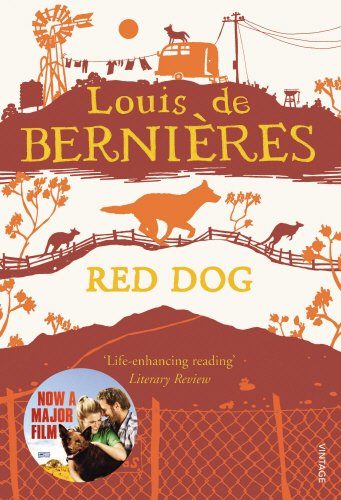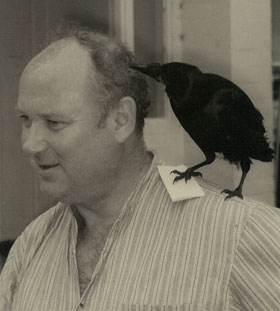
photo crop © Michael McCullough, 2008
*
In this longlisted essay from the 2016 THRESHOLDS Feature Writing Competition, Gina Challen discovers Australia through the tales of Louis de Bernières.
~
Tales of a Traveller:
Red Dog by Louis de Bernières
by Gina Challen
Written in the ten-year gap between Captain Corelli’s Mandolin and Birds Without Wings, you can be forgiven if Louis de Bernières’ collection of short tales Red Dog has passed you by. Though it would be a shame: this is the perfect collection to while away a couple of comfortable hours.
Red Dog is a set of short, snappy tales, each one following the adventures of Red Dog, a kelpie or Australian cattle-dog, and each held to the others by this common thread. The traditional form of these stories has a timeless folktale quality. De Bernières nods his head at such time-honoured favourites as The Tales of Uncle Remus: The Adventures of Brer Rabbit. The tales themselves are straightforward in the telling, uncomplicated, and de Bernières’ simple language creates a style that resonates with the rhythms and cadence of the spoken word. It is this skilful combination that makes them unfussy and readily accessible to readers of all ages. There is a comforting feel, with a kind of deep-rooted familiarity in the prose, particularly at the beginning of ‘Red Dog and the Dreaded Cribbages’:
Back in the time when there were almost no houses and only two caravan parks in Karratha, Red Dog liked to call in on the caravans that belonged to his many friends and providers. He would expect to be washed, de-ticked, and fed, and then he would stay a couple of days until he felt like setting off on his travels once more.
Red Dog particularly liked one of the parks, because that was where his mate Red Cat lived, as well as Nancy and Patsy, but, and it was a big BUT, there was one small problem. Actually, the truth is that there were two big problems, and they were married to each other.
It carries its own expectations: a clear-cut plot waiting to be revealed, an engaging protagonist, jeopardy, and a hero who will win by outwitting his opponents.
De Bernières does not disappoint. The tales are character driven, and Red Dog himself, with ‘every nook of his brain’ engaged ‘in mischievous plans’, lies at the heart of each and every one. Part trickster, part picaro, this is a dog with attitude, as we see in ‘Red Dog Meets John’:
Unlike most dogs, who are happy to spend the day either sleeping or watching life go by, he found life too interesting to stay in one place. He wanted to see what the world was like, wanted to know what was going on round the next corner, wanted to join in with things.
He steals food, hitches lifts, manipulates others to get what he wants and, when asleep, ‘he dreamed of food and adventuring’. Red Dog is a loveable, engaging rogue, a traveller. And travel he does, on foot, in cars, on buses, and on trains. He uses any means to get where he wants to go, even when it carries an element of risk:
Shortly he detected the noise of Patsy’s engine. It had loose tappets and a small hole in the exhaust. As soon as it appeared he ran out in front of it, and Patsy skidded to a halt.
He is a dare-devil, living by his wits.
 Yet the book is more than a collection of simple stories. It is a drawing together of hearsay – word of mouth incidents gathered by de Bernières whilst on a trip around the Pilbara region of Western Australia. Quoted on the back cover of the book, he says: ‘[I] spent two glorious weeks driving around collecting Red Dog stories, visiting the places that he knew, writing up the text as I went along.’ And this is part of the collection’s charm, because the animal is a local celebrity. He has a statue erected in his honour, and has already inspired two other books of short stories and poems. Even before de Bernières’ interest, stories of this dog had become modern folklore. He is a modern folk hero, a myth. Red Dog is a ‘get-together’, a ‘remembering’, a mischievous blend of anecdotal biography and fiction – the dog and the episodes are real, but the characters, with the exception of John, are fictitious. In this way, De Bernières has ensured that the tales are not stale; they have evolved with the re-telling.
Yet the book is more than a collection of simple stories. It is a drawing together of hearsay – word of mouth incidents gathered by de Bernières whilst on a trip around the Pilbara region of Western Australia. Quoted on the back cover of the book, he says: ‘[I] spent two glorious weeks driving around collecting Red Dog stories, visiting the places that he knew, writing up the text as I went along.’ And this is part of the collection’s charm, because the animal is a local celebrity. He has a statue erected in his honour, and has already inspired two other books of short stories and poems. Even before de Bernières’ interest, stories of this dog had become modern folklore. He is a modern folk hero, a myth. Red Dog is a ‘get-together’, a ‘remembering’, a mischievous blend of anecdotal biography and fiction – the dog and the episodes are real, but the characters, with the exception of John, are fictitious. In this way, De Bernières has ensured that the tales are not stale; they have evolved with the re-telling.
The stories’ folktale qualities perhaps come from de Bernières’ aptitude as both a musician and a poet, attributes that are synonymous with the tradition of oral storytelling. The tales do well read aloud, with an easy feel to the narratives, a lack of artifice, and the Aussie slang that peppers the prose – there’s even a glossary of terms at the back of the collection, including terms like ‘Blotto on’, ‘Rotto’, ‘Esky’, ‘Servo’, ‘Ute’ and ‘Wallaroos’. It is as if de Bernières has slipped effortlessly into the mode of a traditional storyteller.
Equally striking is the use of sharp, vivid imagery to evoke the harsh reality of the desert backdrop into which the Red Dog stories are firmly set. He said, in an interview with Anita Sethi, for Granta Magazine:
I always felt that if you live too much in your own head you go mad and disconnected. It’s very important to stay connected with the earth and with things and with people.
And he certainly does that. From the first tale, ‘The Stinker’, he throws the reader into a this world:
…the sun feels like the flat of a hot knife laid directly onto your face. The air shimmers distorting your views of the distance, and you can’t believe that it really is that hot, even if you have lived there for years, and ought to be used to it. If you have a bald patch, and you aren’t wearing a hat, it feels as though the skin on the top of your head is made of paper and has just been set alight.
 This is visceral, this is painful, this is the Australian Outback, unforgiving and relentless. It is also authentic, and it connects with the reader. That de Bernières understands this place is evident, and this lifts the stories from the page.
This is visceral, this is painful, this is the Australian Outback, unforgiving and relentless. It is also authentic, and it connects with the reader. That de Bernières understands this place is evident, and this lifts the stories from the page.
It is a commonly held belief that writers should ‘write what they know’, and maybe part of the appeal of this collection is that de Bernières appears to have done just that. He understands not only the place, but also his central character. He captures the soul of Red Dog, and empathises with him. In some ways they share common ground, both are travellers – as a young man, de Bernières lived in Columbia for a year in the middle of nowhere – and neither have any desire to obey rules. ‘But I just hated being told what to do,’ de Bernières told Kathy Guest in an interview in The Independent. It is interesting to see this sentiment echoed when Nancy, describing an incident with Red Dog at the mall, says:
“So she grabs him by the collar and drags him out, with his feet sliding on the tiles because he’s determined not to go. She closes the door, and before you know it Red Dog’s come back and he’s lying down exactly where he was before.”
De Bernières recognised a kindred spirit in Red Dog’s contrariness and I think it made him smile because there is a sense of joy running through this book. It bubbles along breaking through the surface with gleeful snippets of prose, such as this from ‘Red Dog and the Posh Pooches’:
…whippets from Whim Creek, Rottweilers from Roebourne, poodles from Port Hedland, cairns from Carnarvon, Pekinese from Paraburdoo, pugs from Pannawonica, corgis from Coral Bay, Dalmatians from Dampier, English sheepdogs from Exmouth and even a mutt from Mungaroona.
For me, there can be no doubt that, as he wrote this collection, de Bernières had an awful lot of fun. It is a plucky little book of tales that celebrate the life of a plucky dog, and de Bernières has kept faith with the spirit of the folktale. The stories are simple, nevertheless he has imprinted them with the beliefs, values, history and myths of the society from which these stories originated: the Australian Outback. De Bernières recognises that, by gathering the Red Dog stories and by re-telling them, this is how myths are kept alive, it is how they grow.
It should be mentioned that, since the book was published in 2001, Red Dog’s stories have evolved once again, they have shape-shifted, and this time they have been re-told in a film based on de Bernières’ book. As Jocko says in ‘The Last Journey’: ‘Everyone’s got a Red Dog story … Someone ought to write them down.’ I like the playful irony of this, it is tongue in cheek. I think Jocko would be pleased with the result.
~
 Gina Challen has a Masters in Creative Writing
Gina Challen has a Masters in Creative Writing
from the University of Chichester. She is passionate about short stories, enjoying their intensity and diversity. Her work appears in various anthologies
and has been short listed for the 2015 Bristol Short Story Prize, 2015 Ink Tears Short Story Award, the 2015 Storgy Short Story Award, the 2014 Bridport
prize, The Willesden Herald Short Story prize 2013, the Cinnamon Press Short Story Award 2012 and 2013, The Fine Line Short Story Award and long listed for The Fish Short Memoir Prize 2012. She has read at Shoreham Wordfest 2012 as part of Rattle Tales and her story appears in Rattle Tales 2.

